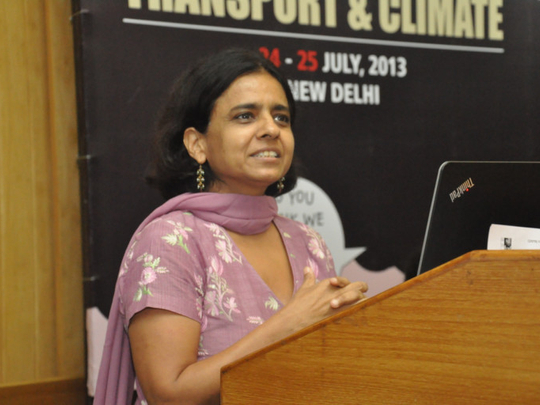
Drought and unseasonable rain unsettling the Indian farmers, with adverse impact on food availability and inflation, can by no means be dismissed as a one-off phenomenon. It’s a part of an immediate narrative illustrating the fallout of climate change.
The pattern of monsoon rainfall, vital to Indian agriculture, has undergone a noticeable change. Rising temperatures have led to a nearly 10 per cent reduction in the duration and rainfall levels, besides an increase in heat waves, hailstorms, cloudbursts and the melting of Himalayan glaciers.
Over the years, India, already the world’s third-largest greenhouse gas emitter, is inching towards a major environmental disaster.
“Climate change will further aggravate food insecurity, sustenance and livelihood issues. Farmers across the Indian subcontinent are faced with uncertainty because of climate variability, untimely monsoon and erratic rainfall affecting crop yield and productivity,” says Sunita Narian, director-general of the Centre for Science and Environment (CSE), New Delhi, a top global environmental think-tank.
While the majority of the world’s population is already faced with hunger, poverty and food insecurity, the UN Intergovernmental Panel on Climate Change (IPCC), in its fifth assessment report, said India may lose up to 1.7 per cent of its GDP if the annual mean temperature rises.
The blistering heatwave currently gripping India has killed more than 2,300 people. Heatwaves are likely to intensify in the future. Over the last century India has turned hotter, with temperatures rising in the range of 0.8° to 1°C and the number of hot days increasing.
“The impact of the high concentration of greenhouses gases (GHGs) and carbon emissions due to anthropogenic activities is already contributing to global warming. A further rise in temperature by 2°C will have a very severe impact on the climate-sensitive sectors such as agriculture, animal husbandry and fisheries. Most importantly, this could lead to increased mortality,” says the environmentalist and writer.
In the past couple of years, India has incurred a huge financial burden and human suffering due to the impact of climate change. Cyclone Hudhud, which hit the states of Andhra Pradesh and Odisha last October, caused an estimated loss of up to Rs700 billion (Dh40.25 billion). “It is imperative to address the impact of climate change through appropriate mitigation and adaptation measures rather than taking short-term measures. It is in India’s interest to treat climate change as a priority crisis,” adds Narain.
According to India’s weather bureau, this March was the wettest in a century, with millions of hectares of crops damaged due to non-seasonal rains, just when the winter (rabi) crop was ripening.
Uttar Pradesh received 4.4 times the normal rainfall; it was 10 times the normal rainfall in Rajasthan, 4.6 times in Haryana, 6.5 times in Maharashtra and 6.7 times in Madhya Pradesh.
An ongoing survey by ActionAid, a global non-profit organisation, has recorded 54 farmer suicides because of freak rains in the Bundelkhand region of Uttar Pradesh in March, while 257 farmers committed suicide in Maharashtra during January-March this year. According to the National Crime Records Bureau, more than 60,000 farmers have killed themselves in Maharashtra since 1995.
According to the latest IPCC report, the impact of climate change would be felt severely in Indo-Gangetic plains. “The areas that are facing frequent floods now may face drought in the near future. We cannot ignore the changes taking place either in the River Indus basin or in River Brahmaputra system over the longer period,” says Aromar Revi, one of the authors of the report.
Meanwhile, hazardous waste is piling up. In the past three decades, Environment (Protection) Act (EPA) has been translated into a range of central rules and regulations, laying down pollution norms and setting rules for the management of hazardous waste. Despite this, India is fast losing the battle of environmental protection.
In 2014, as many as eight industrial incidents were reported. “Many more cases would have gone unreported. The problem is institutional management provisions of legislation remain only on paper. This is the real crisis of India. We have set up the framework but have nothing to fill it.”
It is only now that environmental issues have taken centre stage in the country. Is it too late?
Deaths due to air pollution have increased fourfold — about 5 million each year across the globe over the past decade, according to the latest assessment by the WHO. The database on which the report is based shows that China and India are the worst affected countries, with over two-thirds of the global deaths. And Delhi is the world’s most polluted city.
“In spite of efforts to contain the problem, changed emission standards and setting up institutions to regulate industrial emissions, we cannot catch up in this game of growth and its fallout,” says Narain.
However, there have been some encouraging signs in China. Unlike India, China is building the world’s largest renewable energy system, investing more than $400 billion (Dh1.5 trillion) in clean energy.
Interestingly, while China is all set to play a pivotal role in the global transition to sustainable energy, renewable energy only accounts for about six per cent of power in India — a far cry from its 2020 target of at least 15 per cent, notwithstanding initiatives such as the National Solar Mission to tap the solar power potential of up to 5,000TWh (terawatt hours) per annum.
“Roughly, 80 per cent of human-caused CO2 emissions come from burning fossil fuels. As such, energy must be the priority in mitigating climate change,” says Adnan Z. Amin, director-general of Abu Dhabi-based International Renewable Energy Agency (IRENA).
“China leads in terms of total renewable energy, and individually in hydro- and wind-power installations. But India still has a long way to go. It will have to reduce coal, industrial and vehicular emissions significantly to meet clean air norms,” adds Narain, whose right-to-clean-air campaign 18 years ago is credited for transition to Compressed Natural Gas (CNG) in all public transport buses and three-wheelers in Delhi.
Although the movement for environment conservation in the West started in the 1970s, Narain says, the industrialised countries never looked for sure-fire solutions. “They always stayed behind the problem. Local air pollution is still a problem in most Western cities. But India wants to emulate the disastrous development model of the rich, with much lesser resources and much more inequity and poverty.”
The environmental movement, Narain says, is based on the idea that people do not want anything bad in their vicinity — not in my backyard (NIMBY). “It is another matter that the fight has national policy ramifications, often for the better. But there is also a downside to NIMBY: if it is not in my backyard, then in whose backyard should it be?”
The fact is, the richer we get the more waste we generate. “The more we consume,” Narain says, “the higher the cost of collection and disposal of waste. So, we look for band-aid solutions. In middle-class environmentalism, there is no appetite for changing lifestyles that will minimise waste and pollution.”
Over the years, Narain says, climate change negotiations have become predictable, with no consensus among nations and ambiguity in their actions. The industrialised nations come to each conference of the parties (COP) with a clear game plan — to erase their contribution to the emissions, thereby effectively remove the differentiation between their responsibility and that of the rest of the world.
“This would help them to rewrite the 1992 convention on climate change and let them evade the obligation to provide funds and technology for action in the developing world. The problem is that developing countries do not come with an equally clear plan or proactive position. As a result, developing countries lose,” says Narain.
Apparently, the Indian negotiators believe they can maintain status quo and delay any new agreement, but as climate negotiations show, this tactic does not work. “We block, but the rich countries shove and the ground slips from under our feet. We need to revise our strategy.”
It was decided in Lima that all countries will declare their Intended Nationally Determined Contributions (INDCs) — how much emissions they will cut, why and when. Under the target approach, the world would decide on the carbon budget and set targets for each country based on past contributions to greenhouse gases.
“The review was seen as a dilution of national sovereignty. But since then, India has agreed that the post-2020 climate agreement will not just be applicable to all countries, but all will make voluntary mitigation commitments. So, it has already tacitly agreed to dilute the principle of differentiation.”
But then, it would be unfair to blame the developed countries for not reducing emissions; developing countries increased their “survival” emissions as well. “The need of the hour for all countries is to have a low carbon growth plan. For India, the way ahead is to lay down its emission targets in consonance with its capacity, bearing in mind the benchmark set by developed countries,” she says.
“If India wants to reduce its use of coal, it must invest in solar or biomass or off-shore wind. All this put together will not substantially reduce its dependence on coal because it already faces the challenge to provide affordable power to a huge number of people.”
Although the UN Climate Change Conference in Paris in November is expected to tackle extreme poverty, reduce inequality and minimise risks to development from climate change, Narain is not hopeful of a breakthrough in addressing equity issues. “The ultimate question is whether India takes climate change seriously. If it believes, then it will argue for an ambitious agreement based on equity because that is the only way it can be effective.”
While Indian Prime Minister Narendra Modi recently said the country would not follow the guidelines set by developed countries, but instead “show the way to the world out of the climate crisis”, attributing the crisis to changing lifestyles, Narain says it has become all the more pertinent now for India to change its new growth model.
“The tough part is what begins now for the future. In all high-polluting sectors, technology options for emission reduction will be stagnant after 2020. It will be difficult for India to reduce emissions without impacting growth once it crosses the present emission-efficiency technology threshold.”
The Modi government has deemed economic growth as its top priority but has not paid the same attention to climate change. This is a blind spot especially because scientists across the world have found a link between unseasonable rains, recent earthquakes, heat waves and climate change in India. “It is scared of using the term ‘climate change’ and will look for every reason not to believe that this is a long-term change happening in the country,” Narain says.
–Suparna Dutt-D’Cunha is a writer based in Pune, India.













